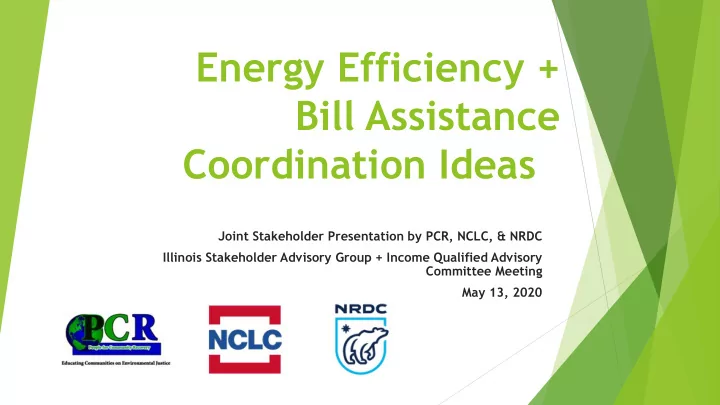

Energy Efficiency + Bill Assistance Coordination Ideas Joint Stakeholder Presentation by PCR, NCLC, & NRDC Illinois Stakeholder Advisory Group + Income Qualified Advisory Committee Meeting May 13, 2020
Background Bill assistance and affordability programs have typically been delivered separately from energy efficiency programs – despite many low-income customers needing both services. It is critical to break down the outreach, marketing, and delivery silos of these essential services. Given the current COVID-19 crisis and the recovery period following, it will be increasing important to serve low-income customers with both bill assistance programs and energy efficiency in a collaborative way to help with overall energy affordability and reductions in shut-offs/arrears. The following PCR, NCLC, & NRDC proposals all look at how to serve low-income customers in a more comprehensive way.
People for Community Recovery (PCR) Proposal: “Lift Up” Model Pilot Local Interventions for Financial Empowerment through Utility Payments Initiative (LIFT-UP) was a 2 yrs. pilot project conducted by the National League of Cities (NLC) in 5 cities: St. Petersburg, Houston and Newark just to name a few This Program targets customers who were behind in their utility payments These customers were offered financial counseling and coaching to restructure their debts into real and achievable payment plans Customers were given one-on-one sessions, which gave them opportunities to look at utility and other debts or concerns in their lives with financial counselors Vital components of the LIFT-UP incentives include reduced or waived fees, holds on water utility shut-offs and one-time credit to their accounts
“Lift Up” Model Pilot Continued Some Results: ➢ Outstanding Balance: Participants in Houston and Newark had notably lower utility bill balances of $170 and $300, respectively, relative to customers who were not offered LIFT- UP at 8 and 12 months after enrolling in the program ➢ Probability of Utility Shut-Offs: Participants in St. Petersburg were 53% less likely to experience utility shut-off during the 12 months after enrolling in the program relative to customers who were not offered LIFT-UP ➢ Key Difference: PCR is trying to use these approaches for customers to give them the tools to make behavioral changes through EE education and physical assessments The overall goal is to coach these customers to reduce their energy costs, avoid shutoffs and learn how EE can help save money on their bills.
NCLC Proposal: Bill Affordability Coordination There should be a holistic approach to delivering energy efficiency to income- qualified customers that provides critical bill assistance, customer rights and energy efficiency information at every customer interaction.** Today, following the economic tsunami triggered by the coronavirus outbreak, the proportion of customers who would qualify as “low - income” has significantly increased in light of the new unemployment and reduced employment figures. New C&C protections will soon be in place. Customer communications within both utility billing and collection and energy efficiency departments need to reflect this new reality. Likewise, due to the significant increase in the number of financially struggling customers, new marketing efforts and ways to identify those most in need of energy efficiency services should be implemented. Utilities should collaborate with stakeholders on messaging approach, important information to be included and delivery strategy. Credit and collections departments should communicate with energy efficiency departments to coordinate EE delivery to those in need. CSR scripts should inform customers of weatherization opportunities. 5 **See, e.g., New York Public Utility Law Project material
NRDC Proposal: Connecting Payment Troubled Customers with EE Target payment troubled customers with energy efficiency (pilot/or program design approach) Bring together utility staffers from credit and collections, bill assistance, IQ SF and MF EE, IQ EE implementers, and interested stakeholders to effectively design and implement the program/pilot This must go beyond referrals and energy efficiency lightbulbs or kits Potential Indicators of Success: improved payment patterns, reduced arrearages, reduced shut-offs, avoided bad debt for the customers, and reduced credit and collections costs to the utility. Background: DTE and Consumers Energy in Michigan running similar programs/pilots now A report by NAACP titled Lights out in the Cold , points to energy efficiency as one solution to helping reduce shut-offs of vulnerable households. Roger Colton in a DTE EE case points to the need and benefits of combining energy assistance/affordability programs and energy efficiency programs Assistance as a short-term solution and EE as a long-term solution to energy burden and affordability issues
Thank You! Questions? PCR Cheryl Johnson, Executive Director, cheryl@pcrchi.org NCLC Karen Lusson, Staff Attorney, klusson@nclc.org NRDC Laura Goldberg, Midwest Regional Director – Energy Efficiency for All, lgoldberg@nrdc.org
Recommend
More recommend